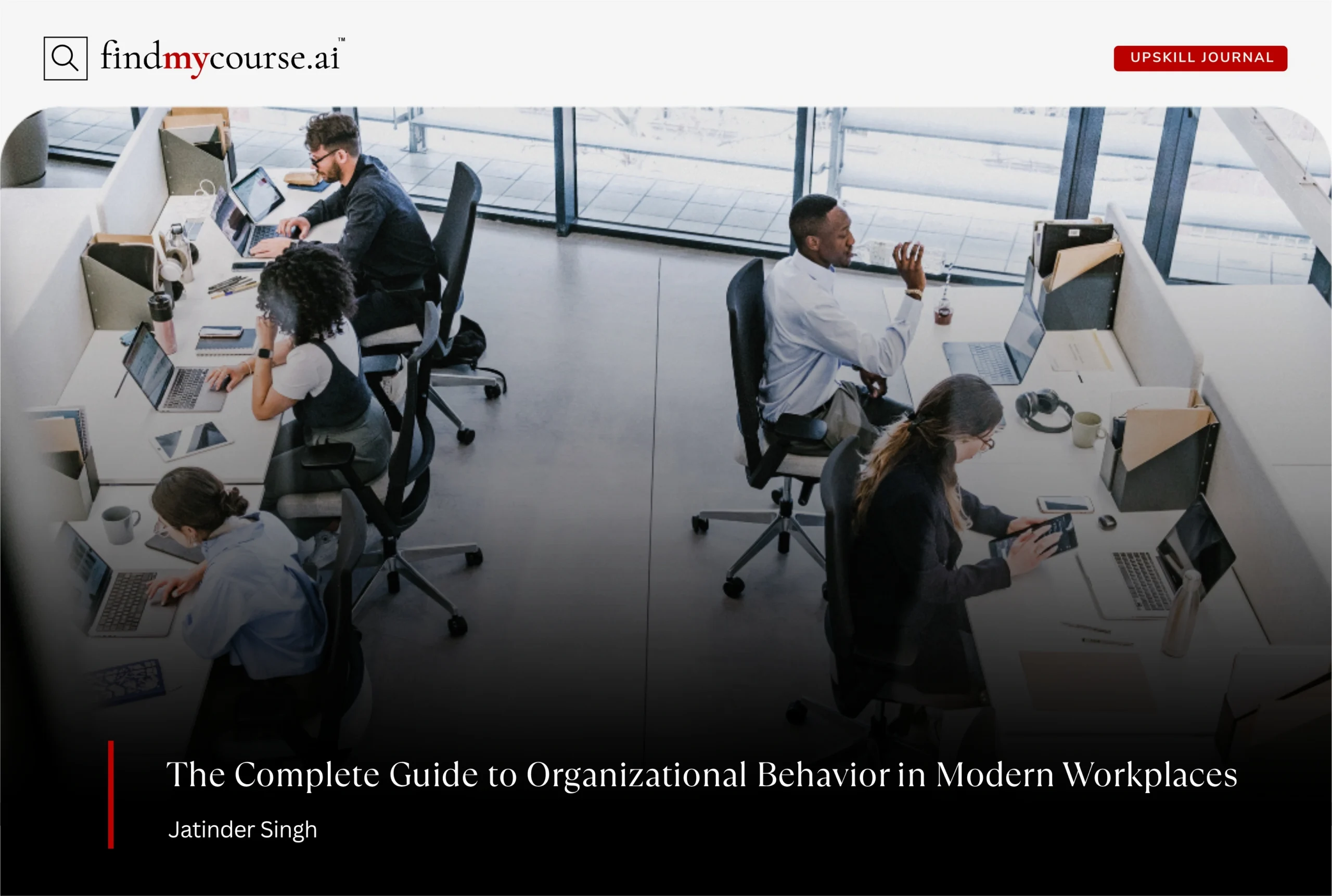Imagine walking into a workplace where every team member seems disconnected, deadlines slip, and communication breaks down—or, conversely, a team where collaboration flows effortlessly, innovation thrives, and everyone feels motivated. What makes the difference? The answer lies in organizational behavior—the study of how people think, act, and interact within organizations. Understanding these dynamics isn’t just for managers; it’s a powerful tool for anyone looking to upskill, lead effectively, and create a workplace where both people and performance flourish. This guide will help you understand the key concepts and practical applications of organizational behavior to thrive in today’s workplace.
Understanding the Meaning of Organizational Behavior
Let’s start simple: What is organizational behavior?
Organizational behavior (OB) is the scientific study of how individuals and groups interact within an organization. In other words, it explores what drives people’s attitudes, motivations, and actions at work—and how these behaviors influence overall performance and culture.
A clear organizational behavior definition from modern management research describes it as “the study of human behavior in organizational settings, the interface between human behavior and the organization, and the organization itself.”
This means OB isn’t just about psychology—it combines insights from sociology, management, communication, and even economics to understand and improve workplace dynamics. When you know what shapes human behavior at work, you can foster better collaboration, resolve conflicts, and create a thriving culture of innovation and trust.
Moreover, in a world where hybrid work, AI tools, and global teams are redefining how we connect, understanding organizational behavior helps leaders and employees adapt with empathy and strategic awareness.
The Core Elements of Organizational Behavior
Every organization, no matter its size or industry, functions through a set of fundamental components. Understanding these elements of organizational behavior is essential for anyone looking to improve team performance, leadership effectiveness, or overall workplace culture. Let’s explore these four pillars in detail.
1. People
People are the heartbeat of any organization. Employees, managers, and leaders each bring unique personalities, skills, and values that influence how work gets done. Their interactions—how they communicate, motivate, and collaborate—shape not only the work environment but also the organization’s overall success.
For instance, a manager who truly understands team dynamics can inspire engagement by recognizing achievements, encouraging open dialogue, and offering support. Moreover, employees who understand their colleagues’ strengths and communication styles can collaborate more effectively. People are more than resources; they are the drivers of organizational culture and performance.
2. Structure
Structure is the framework that organizes how tasks, responsibilities, and authority flow within an organization. A clear structure ensures that everyone knows their role, reduces confusion, and streamlines decision-making.
Whether it’s a small startup with a flat hierarchy or a multinational corporation with multiple layers of management, structure influences how quickly information travels and how efficiently teams work together. In addition, a thoughtfully designed structure allows organizations to respond to challenges with agility, ensuring that productivity remains high.
3. Technology
Technology is no longer just a support tool—it actively shapes how people work and interact. From AI-powered analytics to advanced collaboration platforms, modern technology affects motivation, productivity, and even stress levels.
In 2025, remote work and hybrid models have become the norm, making it crucial for organizations to understand how technology impacts employee behavior. For example, tools that facilitate real-time collaboration can enhance teamwork, while poorly implemented systems may lead to frustration or burnout. Consequently, technology should be viewed not only as an operational asset but also as a behavioral catalyst that shapes organizational performance.
4. Environment
No organization operates in a vacuum. The external environment—including economic trends, social values, legal regulations, and even environmental factors—affects how people behave at work. Recognizing these external influences allows leaders to align organizational strategies with both internal culture and market realities.
For instance, a company operating in a highly competitive tech market may prioritize innovation and agility, while one in a highly regulated industry may emphasize compliance and risk management. By understanding environmental factors, organizations can anticipate challenges, capitalize on opportunities, and cultivate a culture that thrives despite external pressures.
Together, these four elements—people, structure, technology, and environment—form the foundation of organizational behavior. Each component interacts with the others, influencing how employees perform, collaborate, and contribute to the organization’s growth. By paying attention to all four, leaders can create workplaces that are not only efficient but also inspiring and adaptive.
Applying Organizational Behavior in Real Life
You don’t need a Ph.D. to benefit from organizational behavior in your career. Small, intentional actions—when guided by a clear understanding of human behavior—can lead to significant improvements in teamwork, leadership, and overall organizational performance.
For Managers
Managers can use organizational behavior insights to lead more effectively. For example:
- Practice active listening: Truly hear your team’s concerns, ideas, and feedback.
- Provide regular feedback: Offer constructive guidance and recognize achievements.
- Understand individual motivations: Each team member is driven by different factors—some thrive on challenges, others on recognition. Tailoring your approach improves engagement and performance. Tools like the DISC Assessment can help managers understand each team member’s behavior style, making it easier to communicate effectively and motivate the team.
For Employees
Employees can also apply OB principles to navigate workplace dynamics:
- Observe group dynamics: Pay attention to how your team communicates and collaborates.
- Communicate assertively: Share your ideas clearly while respecting others’ perspectives.
- Build trust: Reliable and empathetic behavior fosters stronger relationships and smoother collaboration. Using tools like Google Re:Work Team Surveys, employees can gain insights into team strengths and areas for improvement, helping improve collaboration and communication.
For Organizations
Organizations can create environments that maximize human potential:
- Foster a learning culture: Encourage continuous upskilling, innovation, and experimentation.
- Promote inclusion and feedback: Employees perform better when they feel valued and heard.
- Align policies with behavior insights: For instance, flexible schedules can reduce burnout and increase productivity. Platforms such as the Gallup Q12 Employee Engagement Survey provide organizations with actionable data on engagement, guiding improvements in culture and performance.
Consider a tech startup struggling with high employee turnover. By analyzing employee behavior—such as stress caused by unclear goals or a lack of recognition—leaders can redesign workflows, clarify expectations, and introduce flexible schedules. These changes don’t just solve immediate problems; they cultivate a culture of care, accountability, and motivation.
Ultimately, organizational behavior transforms human insights into actionable strategies. When leaders, employees, and organizations understand and apply these principles, they can create workplaces that are not only more efficient but also more inspiring and human-centered.
The Future of Organizational Behavior: Human-Centered and Data-Driven
As we move deeper into the digital age, organizational behavior continues to evolve. The future workplace blends human empathy with data analytics, allowing leaders and teams to understand behavior more deeply than ever before.
Artificial intelligence and analytics tools can now measure team sentiment, predict burnout risks, and personalize learning paths. For example, platforms like Culture Amp or Officevibe can track engagement trends, while AI-driven learning systems recommend tailored development opportunities. Yet, technology alone cannot replace the human touch—it amplifies it. The most successful organizations will combine these behavioral insights with empathy to build environments that are both high-performing and humane.
Organizations that balance data-driven insights with authentic, human-centered leadership will not only improve productivity but also create workplaces where employees feel valued, motivated, and empowered.
Conclusion
Mastering organizational behavior equips both individuals and organizations to unlock the full potential of their people. By understanding how employees think, communicate, and collaborate, leaders can foster trust, encourage innovation, and enhance overall performance. Applying these insights helps create a work culture that values growth, well-being, and inclusion, while also driving productivity and engagement. In a world where change is constant, organizations that embrace these principles not only adapt more effectively but also inspire teams to thrive. And if you still have questions or need guidance to explore this concept further, our AI assistant is here to help.


